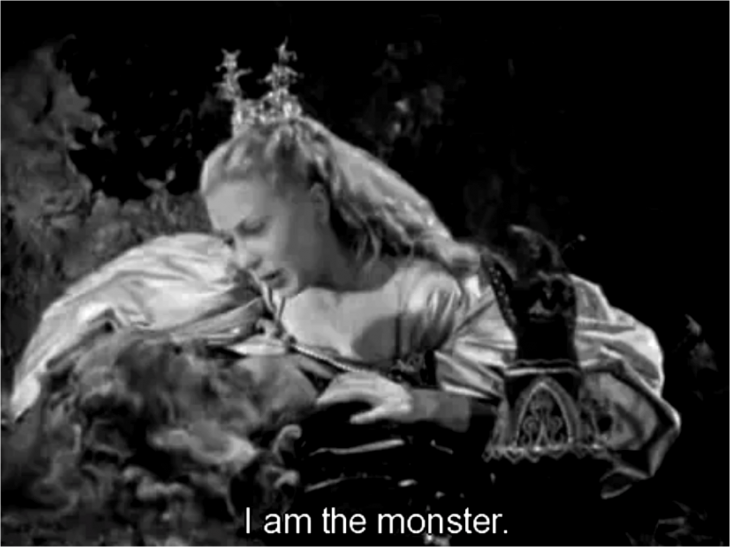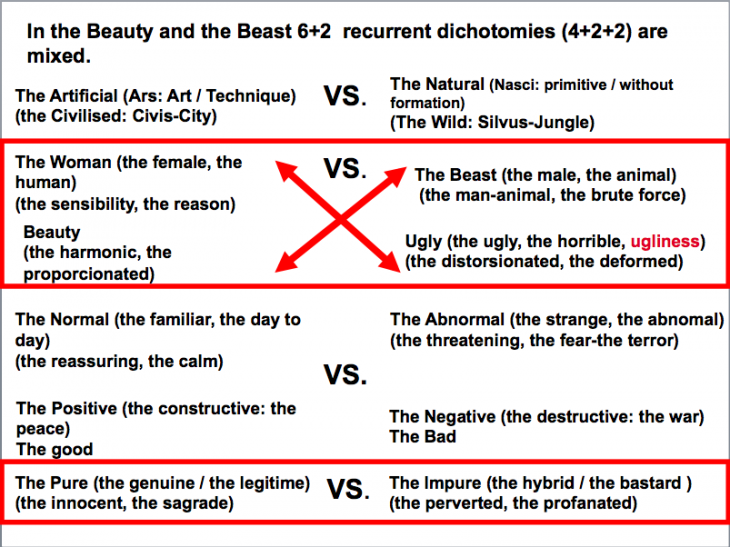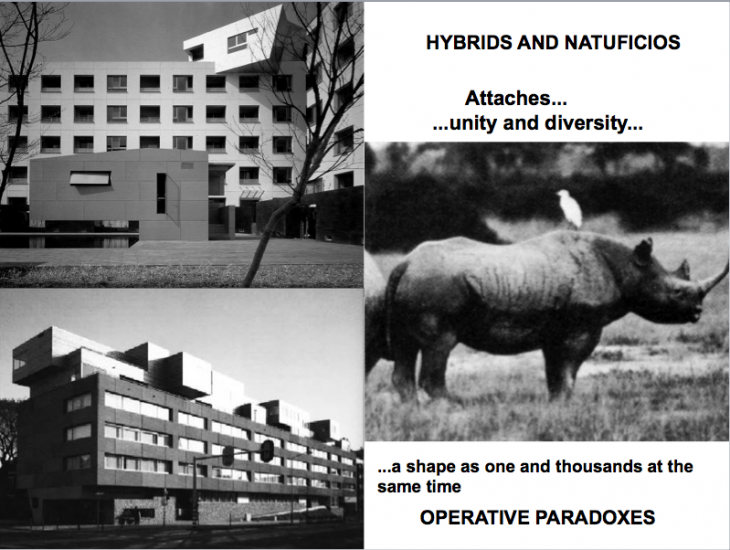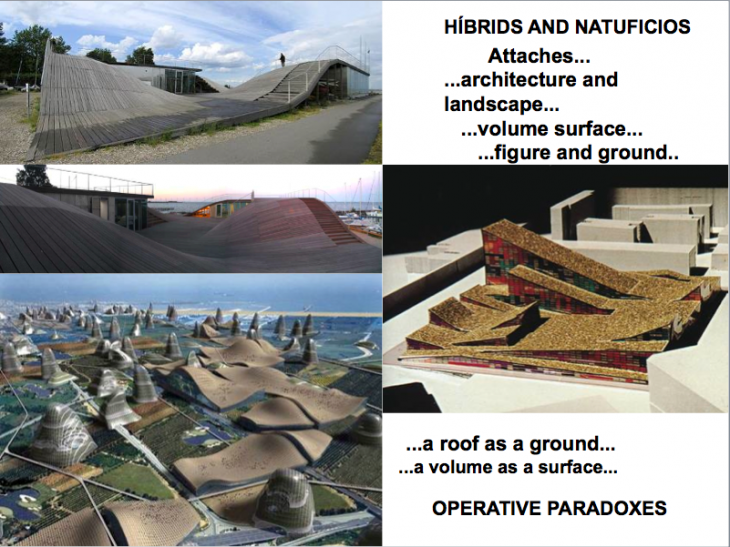Today Manuel Gausa presented the tale of Beauty and the Beast as a paradigm of dualities.
The lecture was presented in four parts:
I. DUALITIES AND DICHOTOMIES: DIVISIONS, OPPOSITIONS AND CONTRAPOSITIONS
II. A RECURSIVE DIAGRAM: LOST PARADISE, LATENT PARADISE, FORBIDDEN PARADISE, THE LOST PARADISE / THE LALTENT PARADISE/ THE FORBIDDEN PARADISE (OR THE HELL)
III. HYBRID SCENARIOS: COUPLING, HYBRIDIZATION AND PARADOXES IN ARCHITECTURE AND THE CONTEMPORARY CITY
IV. RETURNING TO…BEAUTY AND/IS THE BEAST…A HYBRID UNIVERSE.
I. DUALITIES AND DICHOTOMIES
DIVISIONS, OPPOSITIONS AND CONTRAPOSITIONS
The dichotomous division has been at the root of most logical and explorative approaches of reality (classical or modern, symbolic or rational) and refers to a set – or system – of dual categories that divide it on opposite sides and are subject to an antagonistic bipartition.
Dichotomous thought, in this sense, builds a classification method in which hierarchical divisions and subdivisions typically include two parts, two sections, two elements, ie only two mutually exclusive sides..
The dichotomous division is directly associated with dualism as a doctrine that affirms the existence of two separate and antagonistic principles – opposing faced and confronted – and also, in a broader sense, essentially different orders:
Ideal and real, material and spiritual, nature and culture (art), physical order and moral order,
Reason and emotion (sense and sensibility), even and odd, positive and negative, good and evil,
… Masculine and feminine, etc.
Also in the architectonical and traditional logic
the spatial order would be divided in typologic, dichotomic and deterministic taxonomies.
– “up and down”
– “horizontal and vertical”
– “exterior and interior”
– “figure and ground”
– “volume and surface”
– “city and territory”
– “natural and artificial”
– “architecture and landscape”
– “landscape and infrastructure”
– “infrastructure and architecture”
– “skin and structure”, etc.
Then going on to elaborate Film dichotomies depending on a recursive pattern, Film paradigms.
II. A RECURSIVE DIAGRAM
LOST PARADISE, LATENT PARADISE, FORBIDDEN PARADISE
THE LOST PARADISE / THE LALTENT PARADISE/ THE FORBIDDEN PARADISE (OR THE HELL)
Scenarios and recursive schemes that lead to the emancipation/regeneration (through mutation or metamorphosis) of the “monster” (the threat) or to its disappearance (death and/or elimination)
> dissolution of the danger or threat of mix, impurity or “pollution”
RECURSIVE SCHEME
1–Woman –beauty, young– presented in the city ( reassuring scenario > the civilisated, the artificial, the human (ARS)
2– Travel –mandatory and initiation– to the nature: fear and fascination (the strange, the sublime, the wild nature (NATUS)
3– Discovery of the dwelling or fortress of the beast
(mysterious, remote, inaccessible, forbidden… lost paradise…)
4–Appearance and meeting of the being… the monster or the beast
(mysterious, monstrosity, wildness, supernatural, strange, threatening, etc.)
5– Horror and terror, aversion and repulsion, fear and/or rejection.
6– Kidnap and abduction: resistance
7– Forced Retention and mandatory coexistence. Initial rejection, resignation and adaptation.
The monster (the beast) in hia “hábitat”, latent paradise…
8– Approach (subtle and/or explicit). Complicity and gallantry
9–Wish and attraction. Seduction. Temptation and union attempt
> danger of mixture or crossing, of contagion, ”corruption” and/or “pollution”(impurity).
Attempt usually frustrated
10– Outcome: crisis and catharsis. Rupture of the “spell”.
Redemption or disappearance of the being (or sublimation) by:
– regeneration and metamorphosis / tranfiguration of the monster –towards the normalized
– or dead, liberation and elimination of the threat…and of the forbidden paradise…)
END. Recodification of the ancient dichotomic essences: towards the normalized
(interdiction of monsters generation: impure hybrids)
III. HYBRID SCENARIOS
COUPLING, HYBRIDIZATION AND PARADOXES IN ARCHITECTURE AND THE CONTEMPORARY CITY
Beauty and the Beast as a paradigm of dualities. This is expressed in particular through the fear of particular couples, unconventional unions, that is hybrids. These hybrids or unconventional couples, that often are consequent to some form of mutation, are considered forbidden, consequently implying some form of punishment. In architecture there are often mixes, or hybrids. In this sense, these hybrids become operative paradoxes.
Beauty and the Beast depicts this particular paradigm, as, finally, the Beast holds all the elements of Beauty, the Beast is a hybrid himself, a mixture, he is not the contraposition of Beauty, he is simply complex and irregular, as in the open logic environment conditions:
Dynamism (Evolution), Complexity (Simultaneity), Diversity (Plurality), Transversality (Connectivity), Interaction (Interchange)
>>>> Open logic
>>>> Informational order
>>>> Extroverted shape
IV. RETURNING TO…
BEAUTY AND/IS THE BEAST…A HYBRID UNIVERSE.
The Beast is, finally, both:
human (rational, sensible) and animal (irrational, brute)
civilizated (educated,“artificial”) and savage (uneducated, “natural”)
attractive (elegant) and repulsive (rude, deformed)
normal (quotidian) and unusual (strange)
positive (right, generous) and negative (twisted, selfish)
pure (innocent, noble) and impure (perverse, sinuous)
is also
sophisticated and primitive
pleasant and unpleasant
welcoming and horrible
reassuring and threatening
predictable and unpredictable
tolerant and despotic
conventional and heterodox
sensible and fearsome
good and bad
Beast is a mixture
is an hybrid… a crossing…
a impure being… because of complex and irregular
rather than because of perverse o perverted…
This lecture culminated with a revisitation of the tale of BEAUTY AND THE BEAST, in an advanced




